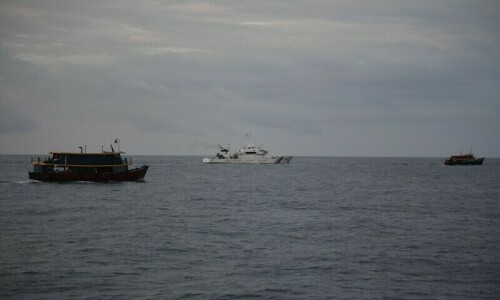ISLAMABAD: Pakistan on Monday attained the credible ‘second strike capability’ as it successfully test-fired nuclear capable submarine-launched cruise missile (SLCM) Babur-III.
“The successful attainment of a second strike capability by Pakistan represents a major scientific milestone; it is manifestation of the strategy of measured response to nuclear strategies and postures being adopted in Pakistan’s neighborhood,” the military said after the test.
The 450km range Babur-III, a sea-based variant of Babur-II — a ground launched missile — was test-fired from a mobile platform in the Indian Ocean to hit a land-based target at an undisclosed location.
The land-attack mode Babur-III is said to be capable of delivering various types of payloads. The successful test, analysts say, would help stabilise the deterrence that had been strained because of India’s sea-based missiles K-4, K-15, Dhanush and Brahmos, which has got land, air and sea versions.
Meanwhile, India is developing another sea-based missile Nirbhay. Babur-III being a cruise missile, analysts believe, is better than the Indian sea-based ballistic missiles.
“Babur-3 SLCM incorporates state-of-the-art technologies, including underwater controlled propulsion and advanced guidance and navigation features, duly augmented by global navigation, terrain and scene matching systems,” the military said while sharing the features of the new missile.
“The missile features terrain hugging and sea skimming flight capabilities to evade hostile radars and air defences, in addition to certain stealth technologies, in an emerging regional Ballistic Missile Defence (BMD) environment,” it added.
The reference to Indian BMD shows that the missile is designed to defeat India’s planned defence missile shield. Pakistani officials had criticised India for nuclearisation of Indian Ocean.
Defending Babur-III’s test, they say, Pakistan had been compelled to go in that direction because of India’s unrestrained behaviour and for maintaining the credibility of its deterrence.
In fielding a credible sea-based nuclear deterrent, Pakistan would now face two major challenges — attaining operational stealth capability for its submarines and ensuring reliability and survivability of communications with the submarines carrying the cruise missiles during war and the eventuality of a first strike by an adversary.
Published in Dawn, January 10th, 2017














































Dear visitor, the comments section is undergoing an overhaul and will return soon.